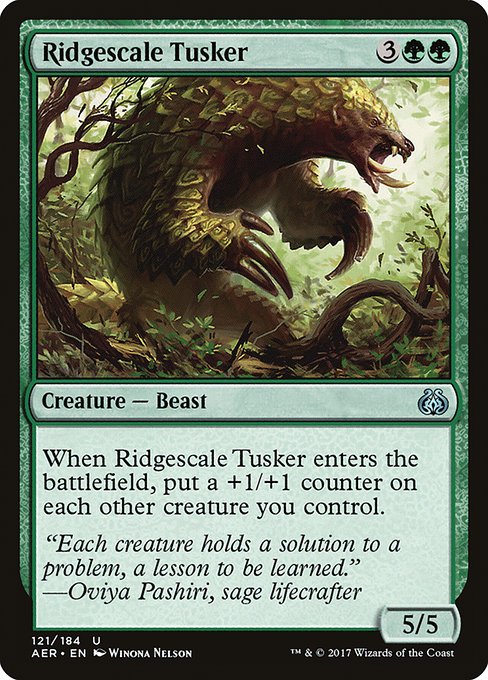
Image courtesy of Scryfall.com
Set-by-set Meta Stability in MTG: A Case Study with a Green Giant
In the ever-evolving landscape of Magic: The Gathering, some cards drift into obscurity while others become quiet anchors in a format’s identity. Ridgescale Tusker is a perfect lens for exploring how a single ETB (enter-the-battlefield) trigger can ripple across multiple sets and formats, shaping strategy long after its rarity and mana cost have faded from memory. Debuting in Aether Revolt, a set celebrated for its brass-tinted tech and artifact synergies, this uncommon green creature arrives for {3}{G}{G}, a respectable 5 mana for a 5/5. The real magic happens when it enters: “When this creature enters, put a +1/+1 counter on each other creature you control.” That line is deceptively simple, yet it creates a cascade of board-state implications that players have returned to in many green-anchored decks across formats. 🧙♂️🔥
The beauty of its design lies in how it accelerates a deck with multiple creatures into a broader board state. It’s not just a one-off stat boost; it’s a catalyst for synergy. In a world where +1/+1 counters and go-wide strategies have found fertile ground in Commander and—on occasion—Historic and Modern, Tusker acts as a stabilizing force. Your early creatures grow, your late-game plans start speaking the same language, and the board presence becomes a creature-crafted cathedral rather than a collection of individual threats. The flavor text—“Each creature holds a solution to a problem, a lesson to be learned.”—reads like a meta-mantra for players who prize incremental advantage and durable board states.
“Each creature holds a solution to a problem, a lesson to be learned.” —Oviya Pashiri, sage lifecrafter
From a gameplay perspective, the ETB trigger is particularly potent in go-wide environments. If you’re casting Tusker into a board already deployed with 2–3 creatures, you’ll watch your team swell into a formidable force as the +1/+1 counters spread forward. The 5/5 body at 5 mana remains a robust tempo piece in formats where ramp and acceleration are common, and its green color identity anchors it to cards that care about board parity. In sets that emphasize artifact synergy, vehicles, or the return-to-green themes of ramp, Tusker’s presence provides a predictable, tempo-friendly line of play that opponents must answer quickly. It’s a classic example of a card that doesn’t rely on flashy wording to feel influential; it relies on clean, scalable math that scales with the board you build. 🎲⚔️
Meta stability across sets is rarely about a single card alone, but about how a card harmonizes with shifts in power, color access, and format popularity. Ridgescale Tusker embodies a steady-state philosophy: it’s not the most dramatic card in a standard metagame, but it offers dependable value that persists as formats swing between control, midrange, and creature-centric archetypes. In Commander, where the deck can grow to monstrous board states and where +1/+1 counters can create exponential returns, the Tusker interacts gracefully with a wide cast of green commanders. Its rarity as an uncommon also makes it an appealing budget option for players building midrange or token-heavy boards without inflating the mana curve. EDHREC data places it outside the upper echelons of popularity (an indicator of niche but enduring presence), yet it’s the kind of card that seasoned players remember when they’re constructing a resiliently green shell. 🧙♂️💎
Design-wise, the choice to couple a midrange body with a universal buff-on-entry creates a flexible template. It’s a reminder that not every game plan needs a heavy-duty engine; sometimes, a single well-timed board-wide push can redefine the late game. The art by Winona Nelson—the pangolin beast with a watchful, moss-draped presence—frames green growth as both a literal and thematic engine. The flavor text bridges the mechanical reality with a broader, almost contemplative message about learning from every creature in your army. In a set like Aether Revolt that married magic with industrial flavor, Tusker lands as a natural artifact of the era: sturdy, reliable, and ready to scale alongside your evolving board. 💡🎨
As metas mature, players sometimes pivot toward tribal or +1/+1 counter-forward strategies in green, but Tusker remains a steady, recognizable pin in the lineup. It’s a card you can slot into a green ramp deck and forget about mid-game only to resurface later as the catalyst for a winning swing. And when you’re scouting for budget-friendly inclusions in a Commander table, it checks both the flexibility and the nostalgia boxes—an evergreen reminder that not every card needs a flashy ability to leave a lasting mark. 🧙♂️🎲
For readers curious about practical access points, the card’s availability extends to both foil and non-foil prints, with modest market presence—an inviting entry point for budget-conscious collectors and players who enjoy building a cohesive green strategy across formats. The card’s evergreen compatibility makes it a talking point when discussing set-by-set stability, because it demonstrates how a single mechanic—enter-tap growth on your board—can anchor multiple deck archetypes as the years roll by. 🔎⚔️
phone case with card holder slim impact resistantMore from our network
- https://blog.digital-vault.xyz/blog/post/ai-generated-paper-patterns-reshape-sewing-for-makers/
- https://transparent-paper.shop/blog/post/master-prototyping-with-adobe-xd-from-sketch-to-prototypes/
- https://blog.zero-static.xyz/blog/post/how-buyouts-impact-small-set-mtg-cards-galvanic-alchemist/
- https://blog.digital-vault.xyz/blog/post/predators-rapport-the-funniest-mtg-jokes-and-nicknames/
- https://crypto-acolytes.xyz/blog/post/how-the-bbc-news-app-keeps-you-informed-everywhere/